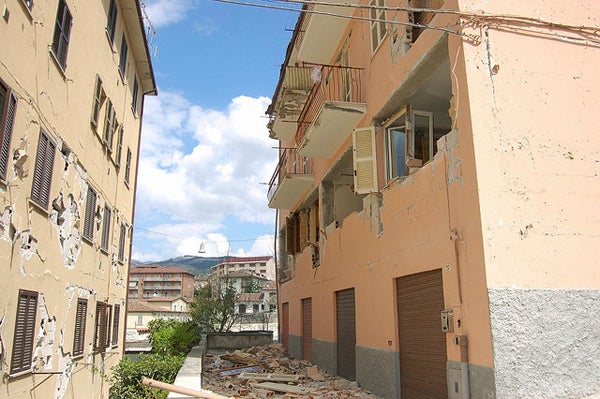|
September 29, 2011
Manslaughter trial of seismologists in Italy highlights need for 'systematic earthquake forecasting,' says Stanford geophysicist
The manslaughter trial of six Italian seismologists highlights the need for scientists to put more effort into explaining their work to the public, says Stanford geophysicist Greg Beroza. He calls for seismologists to issue "earthquake forecasts" on an ongoing basis to help the public understand changes in the likelihood of a major earthquake occurring in a given region. By Louis Bergeron

Apartment buildings in L'Aquila, Italy, after the magnitude 6.3 earthquake that killed more than 300 people and damaged an estimated 20,000 buildings in 2009. (Photo: Leandro Demori/Creative Commons) Six Italian seismologists and one government official went on trial for manslaughter in Italy last week. The unusual trial stems from accusations that the seven failed to adequately communicate the potential for a major earthquake to the population around the central Italian town of L'Aquila, which was hit by a devastating magnitude 6.3 earthquake in the predawn hours of April 6, 2009.
More than 300 people died and an estimated 20,000 buildings were destroyed in the earthquake-prone region.
The charges have sparked international outrage in the scientific community, where many have viewed the trial as an attack on the scientists for failing to predict an earthquake – something that no one has ever demonstrated an ability to do.
According to prosecutors and some of the plaintiffs in a civil suit against the seven, the crux of the matter is not that the scientists failed to accurately predict the earthquake, but rather that they failed to accurately characterize the risks and convey that information to local civic officials and the public.
The region had been experiencing a swarm of low-magnitude earthquakes in the months preceding the April earthquake that caused considerable concern among the populace. But such swarms have never been shown to be reliable predictors of a major earthquake.
"It is a complicated situation, but if the verdict is guilty, I think it will have a big impact on science, well beyond seismology," said Greg Beroza, chair of the Department of Geophysics at Stanford University.
The fact that such charges were even brought has reportedly already had a "chilling effect," making some scientists reluctant to share their expertise with the public for fear of having their statements misunderstood, according to a recent news article in the research journal Nature.
Call for more communication, not less
Beroza advocates outreach, rather than withdrawal. Although seismologists cannot predict earthquakes, they can develop probabilistic assessments of the likelihood that a major earthquake will occur in a given area.
Those assessments could be used to keep people informed about the degree of hazard they face through the issue of regular "earthquake forecasts," similar to weather forecasts. Such forecasts were recommended in a report issued by an international panel of experts convened by the Italian government after the L'Aquila earthquake.
"We are used to statements such as, 'There is a 40 percent chance of rain on Saturday,'" Beroza said. "And part of the reason we are comfortable with that is that we get that sort of forecast day after day, so we come to understand what it really means."
The probabilities associated with earthquake forecasting are much lower than weather forecasting, which will likely take some time for people to get used to.
For example, in the seismically active San Francisco Bay Area, a major earthquake strikes approximately once every 30 years. That amounts to roughly one earthquake every 10,000 days, or a .01 percent chance of a major earthquake occurring on any given day. That's a whole lot smaller than a 40 percent chance of rain.
To complicate things even more, the real value of an earthquake forecast lies in how the probability changes.
Earthquakes tend to swarm
Seismologists know that earthquakes tend to cluster in space and time, so when an earthquake occurs, the probability of having another earthquake increases. Usually those earthquakes are small, but occasionally the subsequent earthquake is big.
The likelihood of a major earthquake occurring might become, say, 100 times as likely as it had been previously. In the Bay Area, that increase might boost the probability of a major earthquake occurring on any given day all the way up to one in a hundred.
So while a 100-fold increase in the likelihood of a major earthquake is a significant change, the probability of a major earthquake is still very small.
"Earthquake forecasting is new territory for the public, in terms of digesting these small probabilities," Beroza said. "But we have to make earthquake forecasting as routine as weather forecasting."
But even though the probabilities remain small, that information could still be significant in terms of preparing for a possible major earthquake. If the probability of a major earthquake goes up by a factor of five, cities could move fire trucks out of firehouses, so they don't get trapped inside if the buildings are damaged. Transporting hazardous materials across vulnerable bridges might be temporarily banned. Schools and hospitals could run earthquake preparedness drills.
"We have to do our best to communicate what we do know about earthquake probabilities," Beroza said.
-30-
|